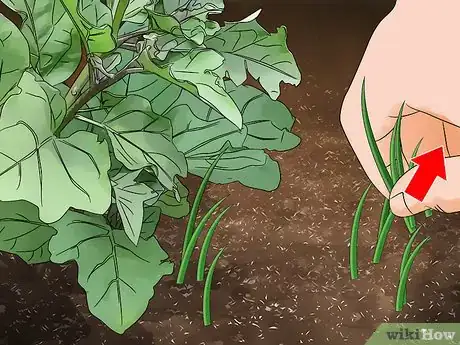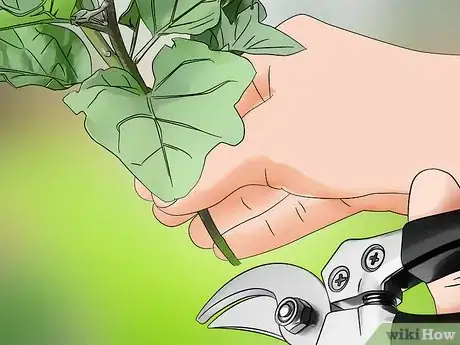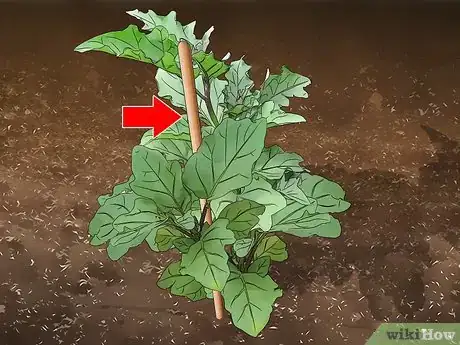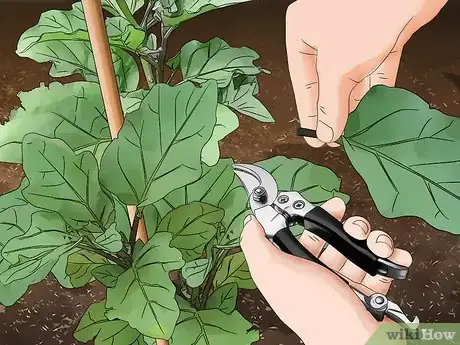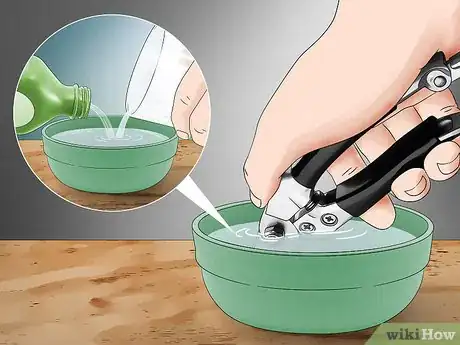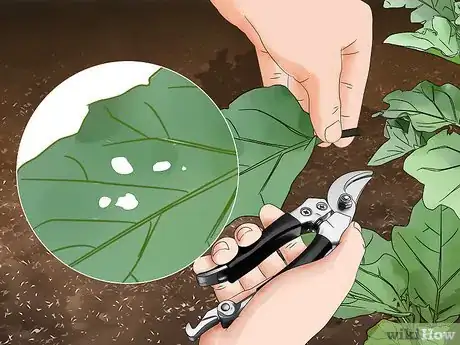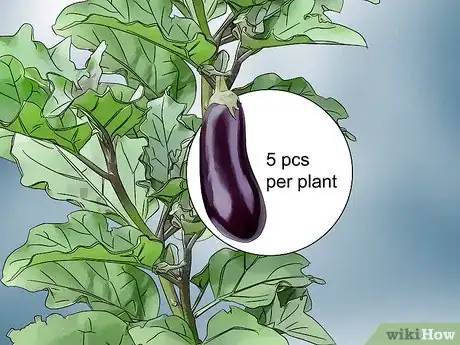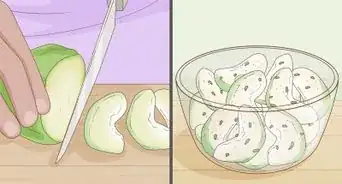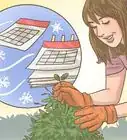This article was co-authored by Lauren Kurtz. Lauren Kurtz is a Naturalist and Horticultural Specialist. Lauren has worked for Aurora, Colorado managing the Water-Wise Garden at Aurora Municipal Center for the Water Conservation Department. She earned a BA in Environmental and Sustainability Studies from Western Michigan University in 2014.
There are 7 references cited in this article, which can be found at the bottom of the page.
wikiHow marks an article as reader-approved once it receives enough positive feedback. In this case, 100% of readers who voted found the article helpful, earning it our reader-approved status.
This article has been viewed 80,851 times.
Growing your own eggplant can provide you with delicious fruit throughout the summer and fall. While starting eggplants takes a bit of effort, maintaining them in the ground is actually pretty easy. All you need to do is stake your plants for support, maintain a few healthy fruits, and pinch off leaves showing signs of infection or flowers 2 to 4 weeks before the first frost.
Steps
Encouraging New Growth
-
1Pinch the first set of flowers as they bud. As your eggplant starts to bloom, pinch the first buds you see coming through. Use your fingers to gently pinch the buds right where they meet the stem of the plant.[1]
- This encourages your plant to put more energy into growing sturdy stalks and deep roots instead of producing new fruit right away. New blossoms will appear in a few weeks, and your plant will be better able to support large, healthy fruits.
-
2Remove old leaves from the lower portions of the plant. As your plant continues to grow, removing leaves from the lower parts of the plant can encourage higher-quality fruit. Pinch leaves from below the flowering areas using your hands or gardening shears to cut them as close to the base of the stem as possible.
- Occasional pruning helps more air and light move through the canopy of the plants, encouraging growth.
Advertisement -
3Pull out any weeds in the growing area as soon as you notice them. Weeds can easily outcompete slower-growing eggplants while they are still getting established. To keep your plants healthy, remove any weeds as soon as you notice them sprouting.
- Be sure to get the roots of the weeds in addition to the leaves. If you just get the top of the plant, it could regrow.
- If weeds are a big problem, you could consider using an herbicide. The exact product you will need depends on your variety of eggplant, as well as whether or not you plan on eating the fruits. Ask your local garden store or nursery for recommendations.
-
4Pinch all new blossoms 4 weeks before the first frost. Pinching new blossoms before the winter encourages the plant to ripen existing fruit instead of putting energy into new growth. You can manually pinch off new blossoms or use garden shears to cut below the base of the blossom.[2]
- Pinch the blossom below the receptacle. It’s better to pinch a little bit more of the stem than to leave a part of the blossom behind.
-
5Prune to the lowest growth before winter to keep it as a perennial. In the fall before temperatures drop and the first frost forms, prune your plant back to the lowest point of new growth. New growth should still be green on the outside and inside. This will require you to harvest any remaining fruit. Then, use pruning shears to make cuts to all the growth on your plant above about 2 inches (5.1 cm).[3]
- Even a light frost will kill eggplant.
- Even though eggplants are perennials, they are typically grown as annuals. Leaving them in the garden over the winter may cause them to have a lower yield over the course of a few years.
- Keeping eggplants as perennials works best in temperate to warm climates since the plants require warm soil to grow. If you expect a hard freeze during winter, you will need to move your plant indoors or into a greenhouse.
Maintaining a Healthy Plant
-
1Stake your plants before they reach 24 inches (61 cm) tall. Eggplant fruits are heavy and can overload the plant if you let them grow too large. Before the fruits get too large, you will need to stake the stems. You can generally use a single wooden stake between 4 to 6 feet (1.2 to 1.8 m) tall, with about a third of their length driven into the ground.[4]
- Drive your stake into the soil about 1.5 inches (3.8 cm) away from the base of the plant. If your plant begins to wiggle or lean toward the stake, stop and reposition it. This could be a sign you’re hitting an important root.
- Once your stake is in the ground, use garden twine or rubber ties to tie back the plant. Always tie just below branches and leaf stems, and leave a little slack so that the stem isn’t damaged and so the plant doesn’t strain or break.
-
2Thin leaves to reduce the risk of fungal diseases. Use gardening shears to thin out the leaves in the center of your plant to grow a healthier plant that’s less likely to contract an infection. If you have a dense plant, you can cut the stalk about 2 inches (5.1 cm) from its base. If you only have 2-3 main stalk, thin out the leaves individually using your fingers or gardening shears to cut them as close to the base of the stem as possible.[5]
- The- leaves in the center of the plant take a lot of the plant’s energy to grow. They are also more likely to get fungal infections like powdery mildew.
-
3Disinfect your pruning tools to prevent the spread of disease. Sanitizing your gardening tools between each pruning can help keep your plant healthy by preventing the spread of pests and disease. Add 1 part bleach to 10 parts water and use a rag to wipe down your shears several times with the solution. Then, rinse them in clean water and dry them fully.[6]
- After disinfecting, use a clean rag to apply a coat of lubricating oil such as WD-40 or boiled linseed oil to the blades of your shears. This helps keep them rust-free and fully functional.
- If you notice your shears getting rusty, you may want to scrub it with a wire brush before disinfecting.
-
4Remove any leaves and blossoms that show signs of pests. Insects and fungal problems are common with eggplants, so it’s important to check them regularly for signs of pests. If you see signs of pests on a leaf, fruit, or blossom, pinch it as close to the stem as possible. You can use garden shears or a gloved hand for this process. Then, apply a garden-safe insecticide. Common signs of infection include:[7]
- Tiny holes in plant leaves or blossoms
- Yellow stippling on leaves
- Yellow masses of insect eggs on the underside of leaves
- Mold or visible rot on plant fruits
- Most plants can handle slight damage from pests without losing crops. Keep the plants well-fed, well watered, and in the proper soil conditions and only chemical insecticides as a last resort.
-
5Maintain 5-6 fruits per plant for larger eggplant varieties. Classic eggplants, black beauties, Ichiban eggplants, and other varieties that grow large, heavy fruits should have no more than 5-6 fruits per plant. Once you have half a dozen blossoms that are maturing nicely, pinch off any additional blossoms until your fruits are ready for harvest.[8]
- You can pinch off blossoms using your fingers or a pair of gardening shears. Just remove the blossom below the stem.
- Limiting the number of fruits on each plant keeps it from getting too heavy and breaking or snapping.
- Smaller variety eggplants such as Indian eggplants and little fingers can maintain up to a dozen fruits per plant.
References
- ↑ https://www.goodhousekeeping.com/home/gardening/a20706884/growing-eggplants/
- ↑ http://www.gardening.cornell.edu/homegardening/scene26b5.html
- ↑ http://articles.latimes.com/2012/dec/18/news/la-lh-how-to-grow-eggplant-as-a-perennial-20121217
- ↑ https://www.veggiegardener.com/threads/how-to-stake-up-eggplant-for-support.1675/
- ↑ http://www.towergarden.com/blog.read.html/en/2015/5/prune_your_plantsfo.html
- ↑ http://www.weekendgardener.net/garden-tool-care/pruners-050805.htm
- ↑ https://www.goodhousekeeping.com/home/gardening/a20706884/growing-eggplants/
- ↑ https://www.almanac.com/plant/eggplants
About This Article
To keep your eggplant healthy, you’ll want to prune it a few times throughout the year. When the first set of flowers come in, gently pinch the buds with your fingers to remove them, which will encourage the plant to grow sturdy stocks and deeper roots. Additionally, prune the lowest growths back with garden shears just before winter. This will prevent frost from damaging the plant. To keep your plant healthy during the summer, thin out the leaves with garden shears, which will help reduce the risk of fungal diseases. You should also remove any leaves or blossoms that have signs of pests, such as small holes, yellow spots, or mold. To learn how to cut back fruit on your eggplant, read more from our Gardening co-author!


